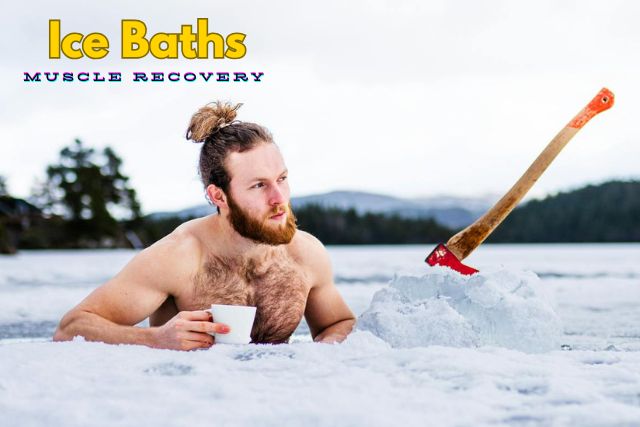
Ice Baths
Ice baths have gained popularity in recent years as a go-to recovery tool for athletes, fitness enthusiasts, and even casual exercisers. But why are ice baths so effective for muscle recovery?
In this article, we’ll dive deep into the science behind ice baths, how they benefit the body, and some tips on how to incorporate them into your recovery routine.
What is an Ice Bath?
An ice bath, also known as cold water immersion (CWI), involves submerging your body in cold water (typically between 50°F and 59°F or 10°C to 15°C) for a short period of time, usually around 10-15 minutes.
Some people add ice to the water to further reduce its temperature, while others may simply use cold tap water. The purpose of this cold exposure is to help soothe sore muscles and reduce inflammation after physical activity.
Reduces Inflammation and Muscle Soreness
The primary reason why athletes and fitness enthusiasts turn to ice baths for muscle recovery is their ability to reduce inflammation and muscle soreness.
When you engage in intense physical activity, your muscles experience small tears, leading to inflammation as part of the body’s natural repair process. While this is normal and part of muscle building, it can also lead to delayed onset muscle soreness (DOMS), which can be uncomfortable for 24 to 72 hours post-exercise.
The cold temperatures of an ice bath help to constrict blood vessels and decrease metabolic activity, reducing the amount of inflammation and swelling.
Once you leave the cold water, the blood vessels dilate, promoting blood flow and helping your muscles recover faster. This can significantly reduce the intensity and duration of DOMS, allowing you to get back to your training schedule sooner.
Enhances Recovery Time
One of the most attractive benefits of ice baths is their ability to speed up recovery. For athletes, especially those who engage in frequent or high-intensity training sessions, minimizing recovery time is crucial. Ice baths help by decreasing the muscle damage that occurs during a workout. This allows the body to repair muscles more efficiently and quickly.
Ice baths also help flush out waste products such as lactic acid that build up during exercise. Lactic acid accumulation is known to contribute to muscle fatigue, so by speeding up its removal, ice baths aid in restoring the muscles to their optimal state faster.
Prevents Injury
Consistent inflammation from repetitive exercise can eventually lead to injury if not managed properly. Regular use of ice baths can help mitigate the inflammation and muscle damage that accumulate over time, acting as a preventive measure. This is especially important for athletes who train intensively and frequently, as they are more prone to overuse injuries.
By reducing inflammation and promoting better muscle recovery, ice baths help maintain muscle integrity and performance, potentially lowering the risk of injury.
Mental Benefits: Boosts Mood and Relieves Stress
Ice baths aren’t just good for the body—they’re also beneficial for the mind. The sudden immersion in cold water can cause an adrenaline rush, which stimulates the release of endorphins, commonly known as the “feel-good” hormones. This can leave you feeling more alert, energized, and in a better mood after the ice bath.
Additionally, the mental challenge of enduring an ice bath can improve mental resilience and focus. Over time, regular exposure to cold can help your body and mind handle stress more effectively, both in your workouts and daily life.
Improves Sleep Quality
A lesser-known benefit of ice baths is their positive impact on sleep. After intense workouts, your body’s nervous system can remain in a heightened state of activation, which can make it harder to fall asleep and rest adequately.
Cold water immersion helps lower your core body temperature, promoting relaxation and signaling to the body that it’s time to rest. This can lead to improved sleep quality, which is crucial for muscle recovery and overall well-being.
How to Take an Ice Bath for Optimal Recovery
While ice baths offer a wide range of benefits, it’s essential to take them correctly to avoid injury or discomfort. Here are some tips for maximizing the effectiveness of your ice bath:
Prepare Gradually
If you’re new to ice baths, don’t plunge right into freezing cold water. Start with cooler water and gradually add ice or use colder temperatures as your body adapts.
Duration
Aim to stay in the ice bath for around 10 to 15 minutes. Staying in for too long can lead to hypothermia or frostbite, so it’s important to limit your exposure.
Water Temperature
Keep the water temperature between 50°F and 59°F (10°C to 15°C). This range is optimal for recovery and helps avoid the dangers associated with excessively cold temperatures.
Warm Up Post-Bath
After getting out of the ice bath, warm up gradually by using a towel, putting on warm clothes, and possibly doing some light movement. Don’t jump directly into a hot shower, as this can cause sudden changes in blood pressure.
Are Ice Baths Right for Everyone?
While ice baths offer significant benefits for muscle recovery, they may not be suitable for everyone. People with certain health conditions, such as heart problems, high blood pressure, or Raynaud’s disease, should avoid extreme cold exposure.
It’s always best to consult with a healthcare professional before incorporating ice baths into your recovery routine, especially if you have any preexisting conditions.
In Summary
Ice baths can be an effective way to accelerate muscle recovery, reduce inflammation, and improve overall athletic performance. Their benefits extend beyond the physical, enhancing mental resilience, mood, and even sleep quality.
When used correctly, they can become a valuable tool in your fitness routine, helping you bounce back faster after intense workouts and preventing injury in the long run. Whether you’re an elite athlete or a fitness enthusiast, ice baths could be the key to unlocking your body’s full recovery potential.
Read Also: Why Adults use Baby Oil






